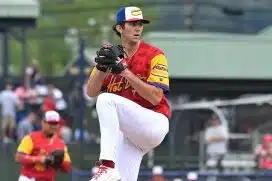Should Maikel Franco's slow start worry the Phillies? (Frank Klose/Sports Talk Philly)
By: Jason Ferrie, Sports Talk Philly Columnist
It has become a common talking point in Philadelphia to discuss what the Phillies' lineup will look like in future years. A major player in those talks is third baseman Maikel Franco. Since his debut in 2014, he has been surrounded by hype and projections. The year in and year out talks of whether he will hit 30 home runs and drive in 100-plus runs fill early season talk radio. Most fans believe he will be here for the long haul, but he is currently in the middle of his worst season as a professional and owns the third-worst wins above replacement total among third-basemen. Is it time for the Phillies to worry about their 24-year-old slugger?
Franco is entering his third season in which he will be on the major-league roster for over half of the games, but the numbers suggest that he is getting worse with each passing season. We will look past his brief stint in 2014 where he played just 16 games and start with the 2015 campaign. In 2015, Maikel Franco played 80 games and finished 1.6 wins above replacement (WAR). In that time, he was also an above-average offensive player with an .840 OPS and wRC+ of 129. This fit what most believed he would be at the next level—a power hitter with lackluster defense. The later was in fact true as he finished 2015 with -8 defensive runs saved at third base. While we can argue about the validity of defensive metrics, the -8 total should be eye opening.
Trending: Cole Hamels high on future of Phillies, won't rule out possible return
The following season Franco played his first full-season in Philadelphia and finished with a .733 OPS and 96 wRC+, both which were underwhelming. The bright spot for Franco was that he hit 25 home runs—which allow most to speculate about whether he could hit 30 or more home runs in a season. Other than that, he walked at a low rate (6.3-percent) and finished with -6 defensive runs saved. Coming into the 2017 season, the thought was that Franco would bounce back from a sophomore slump and be the player everyone hoped he’d be.
Unfortunately for the Phillies, that has yet to become a reality. Franco has played in 35 games this season and the results to this point have been dismal. He currently resides in a tie for the third-worst WAR among third-baseman at -0.2. Along with that, Franco, who is supposed to be known for his offense, has a 69 wRC+, which is the 24th worst total among 28 qualified third-baseman.
We know that he is struggling on offense, but why is he struggling and can it be fixed? The answers usually are in the batted ball data and pitches thrown to the player so let’s start there. As far as exit velocity goes, Franco is right around where he was last year as the chart below displays.
|
Year |
BBE |
Max EV (mph) |
Avg EV (mph) |
Avg FB/LD EV (mph) |
Avg GB EV (mph) |
|
2017 |
112 |
113 |
89.9 |
94.1 |
87.4 |
|
2016 |
479 |
113.2 |
89.6 |
94.2 |
87.6 |
Everything is relatively close here with a slight increase in the average exit velocity—which is a plus. Since the batted ball data is similar, we should look at the what Franco is doing when putting the ball in play, as he may be due for some positive regression.
As I’ll continue to reiterate, slow footed power hitters need to keep the ball off the ground and Franco hasn’t done that. This year, he is hitting ground balls on 44.6 percent of balls in play—which is similar to last year where he did that 44.5-percent of the time. The fly ball rate for Franco has slightly dropped to 33 percent, but that isn’t terrible as he is trading them for line drives—which represent 22.3-percent of batted balls in play.
Phillies Nuggets: What if Jayson Werth had stayed in Philadelphia?
The batted balls are similar, as are the exit velocities, so what gives? The 24-year-old currently has a .215 batting average on balls in play this season. For reference, he had a .271 BABIP last season with a similar batted ball profile, so he may see some positive regression there. The reason for that is that he may be getting some bad luck. Per Baseball Savant’s StatCast data, Franco is barreling up the ball more in 2017 than he did in 2016. While he is hitting the same number of balls at 95+ miles per hour (41.1-percent), his barrels per batted ball event are up to 8-percent from 7.1-percent last year. Franco also has a higher barrel-per-plate appearance than last year at 6.1-percent, compared to 5.4-percent in 2016.
While he is barreling up the ball more this season than last, Franco is experiencing some issues—specifically with the slider. Based on the data, it appears that opponents are taking a more slider-heavy approach this season. In 2016, opponents threw Franco a slider 18.6-percent of the time. This season that rate is up to 23.1-percent. Franco is seeing more sliders and doing less with them. The chart below shows the difference in performance on sliders between 2016 and 2017.
|
Year |
Pitch Type |
Count |
BAA |
SLG |
ISO |
BABIP |
|
2016 |
Slider |
468 |
0.210 |
0.370 |
0.159 |
0.226 |
|
2017 |
Slider |
136 |
0.061 |
0.061 |
0.000 |
0.083 |
That's a pretty shocking drop-off from last year to this—especially with the numbers being low last season. However, using a new StatCast tool called xwOBA, we can track how unlucky Franco has truly been based on the expected wOBA (weight on-base average) using the exit velocity and launch angle of batted balls. The average wOBA of a qualified third baseman this season is .335, so I used that as the number to see how many times Franco has hit a slider with a xwOBA greater than .335. It turns out that Franco has hit five sliders with a xwOBA greater than .335 that ended in an out. Three of the five had an exit velocity greater than 100 miles per hour.
Popular: What if Pete Mackanin was given Red Sox job prior to 2012?
Out of curiosity, I bumped the criteria to a xwOBA greater than .400 against all pitches that resulted in an out. It turns out that Franco has hit 18 balls this season with a xwOBA greater than .400 that have resulted in an out. Now that is bound to happen as sometimes the ball finds a defender, but it is may be a sign that he is in store for some positive regression.
I think Franco is certainly due for some positive regression given his batted ball data, but there are some concerns. Teams are attacking him in a different way this season and that will require him to adjust. Along with that, he needs to be a better defender at third base if he is going to be a long-term solution for the organization. During his career, he has yet to exceed 2-WAR and has been below league average on offense over the last calendar year. It’s too early to give up on the 24-year-old, but it may be time to worry that he is just going to be an average third-baseman.







